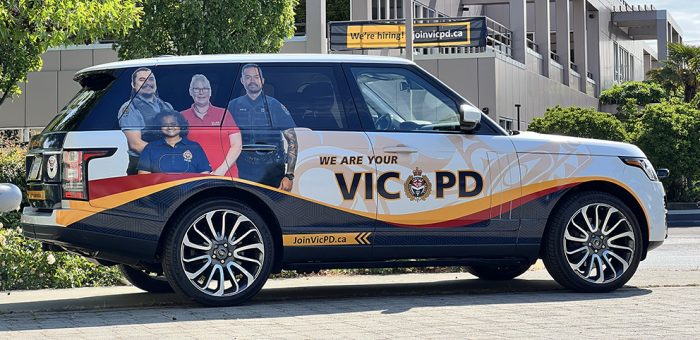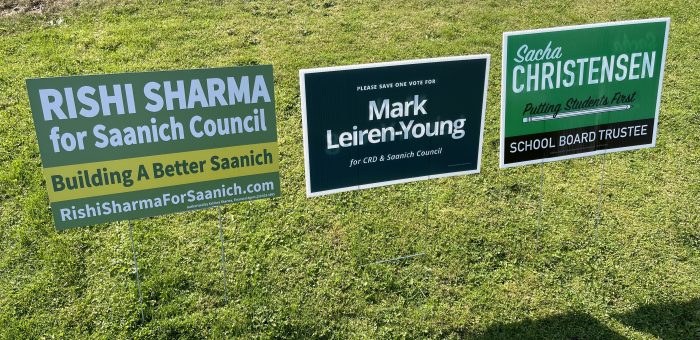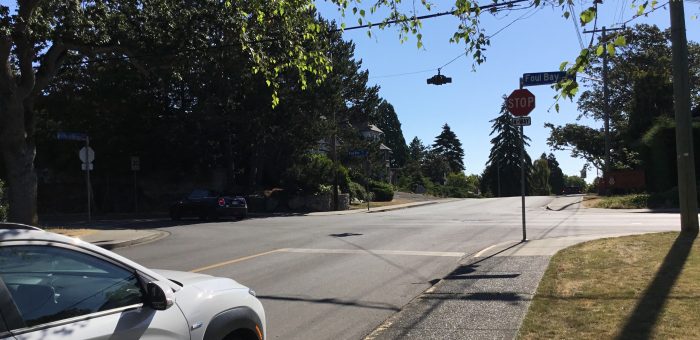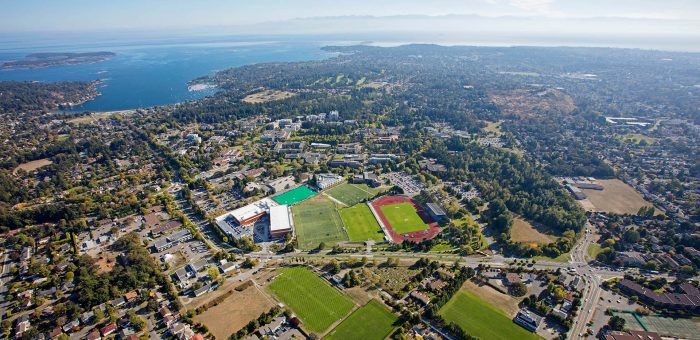Local Government
When ideology trumps evidence: The decision to cancel the school liaison officer program in School District 61
On May 31, 2023 and in what can only be described as a textbook example of ideological decision-based evidence-making, Trustees voted unanimously to cancel the school liaison officer (SLO) program in all School District 61 (SD61) schools (the only school district in BC to do so). The Vancouver School Board, which had previously eliminated school liaison officers in 2021, reinstated them in September 2023.
Remarkably, the SD61 decision was reached without consultation with any Police Board in the region or the leadership of either the Esquimalt or Songhees First Nations. In support of their decision, School Board Chair, and former BC Green candidate for Oak Bay-Gordon Head, Nicole Duncan demonstrated a fundamental misunderstanding of the role of SLOs and the community policing model (ironically in a community she wanted to represent in the BC Legislature) by stating “Police are being asked to fill in gaps in student support and to take on roles that should be filled by individuals with specialized expertise, such as youth and family counsellors and social workers“.
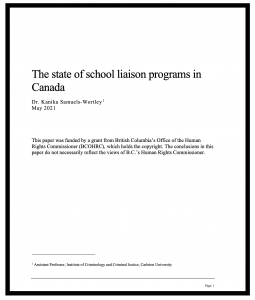 The SD61 decision built on a bizarre press release issued by the BC Office of the Human Rights Commissioner on November 22, 2022: Letter to school trustees on human rights concerns with the use of School Liaison Officers in B.C. schools. While obviously an overreach of the mandate of the unelected BC Human Rights Commissioner, she stated “I strongly recommend that all school districts end the use of SLOs until the impact of these programs can be established empirically. ” I was serving on the the Oak Bay Police Board at the time and was very familiar with Oak Bay’s community policing model and the important preventative role that school liaison officers play in such a model. I had hoped the Human Rights Commissioner letter was supported by extensive research on SLOs in BC Schools. Sadly, all that I could find was a single report commissioned by her office known as the Samuels-Wortley report.
The SD61 decision built on a bizarre press release issued by the BC Office of the Human Rights Commissioner on November 22, 2022: Letter to school trustees on human rights concerns with the use of School Liaison Officers in B.C. schools. While obviously an overreach of the mandate of the unelected BC Human Rights Commissioner, she stated “I strongly recommend that all school districts end the use of SLOs until the impact of these programs can be established empirically. ” I was serving on the the Oak Bay Police Board at the time and was very familiar with Oak Bay’s community policing model and the important preventative role that school liaison officers play in such a model. I had hoped the Human Rights Commissioner letter was supported by extensive research on SLOs in BC Schools. Sadly, all that I could find was a single report commissioned by her office known as the Samuels-Wortley report.
I thoroughly reviewed the Samuels-Wortley report. It provides a literature review of studies pertaining to SLO programs in Canada and the United States. First, it’s important to note that the author states on page 3 of her report “an extensive review of the literature reveals no peer-reviewed studies that explore the impacts of Canadian SLO programs on marginalized students.” In fact, one of the five peer-reviewed Canadian studies the author found pertaining to Canadian SLOs suggested positive outcomes when introduced as a component of a community policing model (Broll and Howells, 2019).
 The US-based research reviewed in the Samuels-Wrotley report focussed on the “school-to-prison” pipeline, violence, US-based SLO training protocol etc. and cannot be generalized to Canada. Even the Toronto Police internal evaluation reviewed in the Samuels-Wortley report is not generalizable to Greater Victoria as they were assessing a targetted SLO program introduced after the fatal shooting of a student at a Toronto high school, not as a key component of a community-policing framework.
The US-based research reviewed in the Samuels-Wrotley report focussed on the “school-to-prison” pipeline, violence, US-based SLO training protocol etc. and cannot be generalized to Canada. Even the Toronto Police internal evaluation reviewed in the Samuels-Wortley report is not generalizable to Greater Victoria as they were assessing a targetted SLO program introduced after the fatal shooting of a student at a Toronto high school, not as a key component of a community-policing framework.
The SD61 decision was also supported by a thoroughly debunked letter from the Greater Victoria Teacher’s Association who had apparently not surveyed their members before coming up with their supposedly (but clearly not) researched ideological position. On the other hand, the Victoria Principals’ and Vice Principals’ Association, whose members are in charge of individual school management wrote a strong letter of support for SLOs to the Board of Trustees that was apparently ignored.
What’s most odd about the GVTA letter is that in April 2018, when I was serving in the BC Legislature as the MLA for Oak Bay-Gordon Head, Victoria Police cut their SLO program after not being given the resources to maintain their frontline services. By December 2018, the Greater Victoria Teacher’s Association began a campaign to get police liaison officer’s back in Victoria Schools that continued into 2019 as school-based incidents started to rise. The GVTA’s dramatic policy lurch strikes me as a textbook example of what happens when one or two idealogues start ramming through their agenda while claiming to speak on behalf of the collective.
 Rather than choosing to consult with those delivering or providing oversight into the SLO program, School Board Trustees seemed to be swayed by those purporting to have uncovered gotcha evidence from FOI information they received. The egregious misinformation brought forward in this regard provided the “evidence” to support the ideological narrative needed to justify a predetermined decision (so-called decision-based evidence-making) to eliminate SLOs from SD61 schools. For example, on X (formerly known as Twitter), one activist offered gotcha ‘proof’ that VicPD were targeting members of the BIPOC community. They pointed out that 19% of all “youth suspects” arrested by VicPD were indigenous whereas only 5% of the population was indigenous. What they failed to point out was that the data they were looking at was aggregate rather than individual data. To illustrate this, suppose there were 100 arrests & one BIPOC individual committed 19 of them. Suppose the other 81 were committed by 81 different other folk. Then the statistic is only 1.2% of people VicPD labeled as “youth suspects” were BIPOC. Perhaps the activists would have served our community better if they educated themselves on the data before making incorrect assertions.
Rather than choosing to consult with those delivering or providing oversight into the SLO program, School Board Trustees seemed to be swayed by those purporting to have uncovered gotcha evidence from FOI information they received. The egregious misinformation brought forward in this regard provided the “evidence” to support the ideological narrative needed to justify a predetermined decision (so-called decision-based evidence-making) to eliminate SLOs from SD61 schools. For example, on X (formerly known as Twitter), one activist offered gotcha ‘proof’ that VicPD were targeting members of the BIPOC community. They pointed out that 19% of all “youth suspects” arrested by VicPD were indigenous whereas only 5% of the population was indigenous. What they failed to point out was that the data they were looking at was aggregate rather than individual data. To illustrate this, suppose there were 100 arrests & one BIPOC individual committed 19 of them. Suppose the other 81 were committed by 81 different other folk. Then the statistic is only 1.2% of people VicPD labeled as “youth suspects” were BIPOC. Perhaps the activists would have served our community better if they educated themselves on the data before making incorrect assertions.
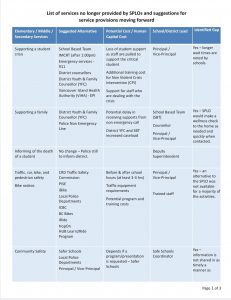 In another example, a powerpoint presentation to a School District committee on SLOs seemed to have been particularly influential even though none of the purported “gotcha” statistics were checked with VicPD and most were misinterpreted. Sadly with gangs now having increased access to schools, vulnerable youth become easy victims for grooming into gang life. But that’s not the only consequence of the irresponsible School Board decision. Here’s an incomplete list of what the Board has identified as services the SLOs used to provide that now fall into the responsibility of already overburdened principals and vice-principals, along with the District’s lone Safe Schools Coordinator. This list also illustrates the challenges faced by schools and students since the removal of the SLOs.
In another example, a powerpoint presentation to a School District committee on SLOs seemed to have been particularly influential even though none of the purported “gotcha” statistics were checked with VicPD and most were misinterpreted. Sadly with gangs now having increased access to schools, vulnerable youth become easy victims for grooming into gang life. But that’s not the only consequence of the irresponsible School Board decision. Here’s an incomplete list of what the Board has identified as services the SLOs used to provide that now fall into the responsibility of already overburdened principals and vice-principals, along with the District’s lone Safe Schools Coordinator. This list also illustrates the challenges faced by schools and students since the removal of the SLOs.
• Longer wait times accessing crisis support for students.
• Loss of student support as staff are pulled to support the critical student.
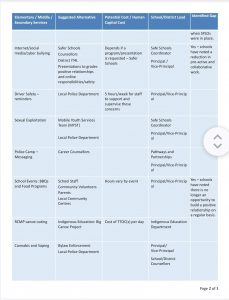 • Additional training cost for Non-Violent Crisis Intervention (CPI).
• Additional training cost for Non-Violent Crisis Intervention (CPI).
• Support for staff dealing with the crisis.
• Delays in receiving supports from police departments nonemergency calls.
• District Youth and Family Counsellor (YFC) and School-Based-Team (SBT) increased caseload.
• Alternatives are not available for a majority of activities.
• Additional program, training, and equipment costs.
• Information around community safety is not being shared in a timely manner.
• Reduction in pro-active and collaborative work around internet/social/media/cyber bullying.
• No longer an opportunity to build a positive relationship on a regular basis.
• Increase in vandalism and graffiti on school grounds.
• Students no longer have an opportunity to learn through a police focused lens.
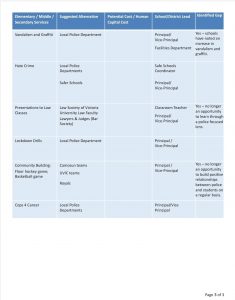 • There is no longer an opportunity to build positive relationships between police and students on a regular basis.
• There is no longer an opportunity to build positive relationships between police and students on a regular basis.
The following programs or presentations are missing from this list that the District provided:
• Gangs in (BC)
• Personal Safety
• Female Personal Safety
• Halloween Safety
• Healthy/unhealthy Relationships
• Human Trafficking
• LGBTQ Presentations
• PARTY program
• Property & Vehicle Crime
• Shoplifting
• Stranger Danger
• Street Drugs
• WITS program
• Mentor individual students
While at present, the Board of Education is certainly within its right to ban SLOs from their schools, community safety falls within provincial and local government jurisdiction. My hope is that the province will step in to rectify what has happened in SD61 through the introduction of legislation or regulation to ensure that such ill informed decisions cannot occur in the future without either provincial approval or consultation with the affected police boards (charged with oversight of policing). Nobody’s interests are served when our collective safety is undermined by poorly thought through decisions that are grounded in nothing more than ideology and virtue signalling.
I wish to offer my sincere thanks to all police officers in our region for their continued service to our community. I can only imagine how decisions like this, based on nonsensical rhetoric and misleading information, affect your morale. Yet the same activists undermining our region’s policing would almost certainly be the first ones to call for your help when a problem arises. Finally, I can’t imagine how police officers feel as they go to pick their children up at school while dressed in uniform knowing that new school district policy requires schools to log when officers are on school property.
Shame on the Greater Victoria School Board.
Thoughtful voices: Sacha Christensen, Mark Leiren-Young & Rishi Sharma
In 2012, as I started my journey to become the BC Green MLA for Oak Bay Gordon Head, I was only too aware of how difficult it would be to win against the incumbent, BC Liberal Ida Chong. I was running for a party that had never elected anyone at the provincial level anywhere in Canada. There were no “party lists” that we could draw from; there was no party “apparatus” to call upon; there was no real “election readiness” or “provincial strategy”. Each of the BC Green candidates had to organically grow their support from the bottom up. And we did so against difficult odds and without access to organization networks like those associated with the so-called BC NDP ground game. I believed that the pathway to victory involved vowing to do politics differently and promising to work with whomever formed government. Ultimately, this approach was successful and I was able to advance numerous bills working collaboratively with the BC Liberals (from 2013-2017) and then the BC NDP (from 2017-2020).
When we elect politicians to govern on our behalf, we are electing individuals who are each armed with a toolkit of life skills, experiences, qualifications and views. Ideally, each elected person has a complementary, rather than identical, set of tools in their tool kits. For when these complementary tools are spread out on the decision-making table, more creative, inclusive and thoughtful policy and solutions are built. But in my view, what is most important is that we elect individuals who recognize the importance of advancing lasting policy through good governance that transcends traditional partisan divides.
On October 15, we go to the polls in the next general local elections. While I have already voted in an advanced poll for a full and diverse slate of School Board and Council candidates, I wanted to highlight three remarkable individuals on my list. These individuals span the political spectrum, and exemplify what I look for in an elected leader. None of them are presently holding elected office and there are enough incumbents not running to ensure that new people must be at the Saanich Council and School District 61 Board tables. I provide my rationale as to why I voted for these three individuals to help others as they do their research on who they will support on October 15. I recognize the importance of name recognition in local government elections and perhaps by doing this, I might convince a few of you to reach out to the three candidates below to learn more about their compelling campaigns.
1) Sacha Christensen – candidate for SD61 Trustee.
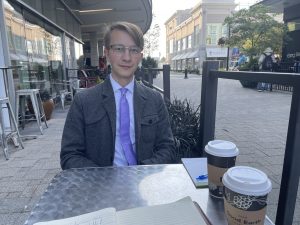 Despite the apparent lack of attention given to school board elections, Trustees in School District 61 actually manage a bigger budget ($268 million for 2022-23) than do the Mayor and Council of Saanich ($222 million for 2022-23). Over the past year, School District 61 was rocked with controversy as two trustees were suspended and subsequently reinstated. The annual budget process was also not without its own public controversy as music and support services took a hit to make ends meet. Given the turbulence of the past year, and with Board Chair Ryan Painter, Angie Hentze, and long time Trustees Elaine Leonard and Tom Ferris not seeking reelection, it is important to elect individuals with demonstrated expertise and experience who understand the importance of a collaborative, as opposed to an adversarial, approach to good governance.
Despite the apparent lack of attention given to school board elections, Trustees in School District 61 actually manage a bigger budget ($268 million for 2022-23) than do the Mayor and Council of Saanich ($222 million for 2022-23). Over the past year, School District 61 was rocked with controversy as two trustees were suspended and subsequently reinstated. The annual budget process was also not without its own public controversy as music and support services took a hit to make ends meet. Given the turbulence of the past year, and with Board Chair Ryan Painter, Angie Hentze, and long time Trustees Elaine Leonard and Tom Ferris not seeking reelection, it is important to elect individuals with demonstrated expertise and experience who understand the importance of a collaborative, as opposed to an adversarial, approach to good governance.
After being told by one of my children that I should consider voting for Sacha, I decided to interview him to learn more about why he was running to be a School Board Trustee at the age of 24. I was extremely impressed by his maturity, thoughtfulness and profound insight into civic and school politics.
Sacha graduated from the challenge program at Esquimalt High School and has completed his first two years of political science at Camosun College. For the past three years he has been working as the constituency assistant in Randall Garrison’s MP office. Constituency assistants play a critical non partisan role in an MP or MLA office. They are the front line staff who interact with and help constituents access the services available to them. As such, they are the public face of an MP or MLA in many community interactions. They should be unconditionally ethical and trustworthy, articulate, have exemplary interpersonal communication skills, hard working, intelligent and empathetic. It became quickly obvious to me why Randal Garrison had hired Sacha.
I asked Sacha why he chose to run to become a Trustee. He pointed out that the present make up of the Board was closer to retirement than to being back in school and that he felt it was critical to ensure students were always front and centre in School Board decision-making. He expressed concern over the 49% 5-year (57% 6-year) indigenous graduation rate in the district and the emergence of the VIVA slate of candidates who he did not believe shared his values. We talked about the lack of funding for students with diverse abilities and the troubling provincial model of education funding. I came away with the impression that Sacha was an exceptionally pragmatic thinker who understands how to advance policy solutions by bringing people together.
In summary, I am very impressed with Sacha Christensen’s collaborative approach to politics, as well as his perspective as a young candidate. I believe he has the expertise and experience to restore good governance to our school board.
More information on Sacha Christensen’s quest to become a Trustee in School District 62 is available on his campaign website.
2) Mark Leiren-Young — candidate for Saanich Council
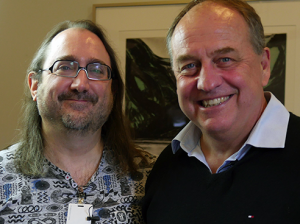 I first met Mark many years ago when he came to interview me at my office at the University of Victoria. Mark was doing a podcast series on trees and I had just completed my book: Generation Us – The Challenge of Global Warming. We hit it off right away.
I first met Mark many years ago when he came to interview me at my office at the University of Victoria. Mark was doing a podcast series on trees and I had just completed my book: Generation Us – The Challenge of Global Warming. We hit it off right away.
A few years later, I once more bumped into Mark on the set of Wes Borg’s live comedy show, Derwin Blanshard’s Extremely Classy Sunday Evening Program, a show that I had become a regular on before I got elected. He sang “Kumbaya” as I proceeded to “beat the character of an Irish ambassador to Canada“, who was cast as a rabid climate change denier on the show, with a large “Nobel prize” prop! It was good-natured humour and Mark and I saw each other in different lights! It was also the last show I did before getting elected! And then in 2017, Mark interviewed me again in the final days of the 2017 provincial election campaign just prior to our historic election result, wherein the BC Greens were afforded the balance of power in the 2017-2020 BC NDP minority government.
Mark has been surrounded by politics his entire life. His mother met his father when she was running for Vancouver City Council and he was covering it for The Vancouver Sun. His father went on to become the legislative reporter for The Sun and then Bill Bennett’s press secretary. Mark also covered politics as a journalist for years and – among other gigs – used to write for a magazine called Trade and Commerce where he helped translate municipal business plans into plain language to draw businesses and investors to municipalities throughout the lower mainland. He was approached about becoming the city hall columnist for a couple of Vancouver’s better media outlets. And he started writing for the Monday Magazine while he was still a UVic student.
Mark is an exceptionally gifted artist and communicator. He’s won numerous awards for his books, television, theatre and film productions and teaches in University of Victoria’s creative writing department. Virtually all of his work, including some of my his commercial work, has involved social or environmental themes. Mark is creative, collaborative, innovative, pragmatic and understands how to work across partisan divides to advance inclusive policy for our community.
More information on Mark Leiren-Young’s quest to become a Saanich Councillor is available on his campaign website.
3) Rishi Sharma — candidate for Saanich Council
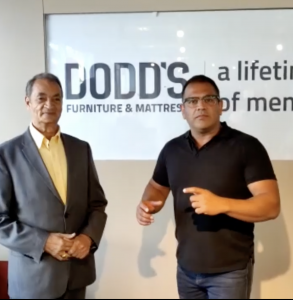 Rishi and I got to know each other in the 2013 provincial election campaign. He was the BC Liberal candidate for the riding of Saanich South and was running against my friend and colleague (from my days in the legislature), Lana Popham.
Rishi and I got to know each other in the 2013 provincial election campaign. He was the BC Liberal candidate for the riding of Saanich South and was running against my friend and colleague (from my days in the legislature), Lana Popham.
While I first met Rishi during an in-studio CFAX 1070 interview/debate early in the campaign, I got to know him better following an all candidates meeting that we we both participated in. Organized by the BC Sustainable Energy Association, this was a packed public event held at the Fernwood Community Centre on the theme: Energy and Climate. Rishi represented the BC Liberals. Rob Fleming (NDP), Duane Nickull (BC Conservatives) and I (BC Greens) were our party nominees. To no one’s surprise, the audience was not particularly warm towards the incumbent BC Liberal government. Yet it was clear to me why the BC Liberals sent Rishi to represent them. He was a compassionate listener and a thoughtful speaker.
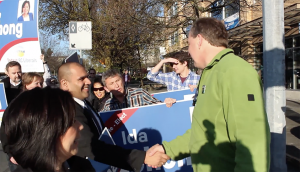 What also struck me early on about Rishi was the respect, ethics and integrity he brought to his election campaign. We were both representing different political parties, yet we were both able to converse in a collaborative way. We focused on our shared values and spoke about how we could advance creative solutions to the issues facing the province. And over the decade since we first met, I have followed Rishi’s work within the BC Government.
What also struck me early on about Rishi was the respect, ethics and integrity he brought to his election campaign. We were both representing different political parties, yet we were both able to converse in a collaborative way. We focused on our shared values and spoke about how we could advance creative solutions to the issues facing the province. And over the decade since we first met, I have followed Rishi’s work within the BC Government.
Unlike many candidates running for local government positions, Rishi was born in, grew up in, and still lives in the community of Saanich. He attended Hillcrest Elementary, Arbutus Junior High and Mount Doug High School. His postgraduate studies include classes at UVic, Camosun and, more recently, Royal Roads university where he is finishing off his MA in Organizational Leadership. Rishi was also an accomplished athlete, playing soccer for Gordon Head, Metro Victoria and the BC Selects, while also competing in field hockey. He continues to give back to the community as a volunteer coash with Saanich Fusion soccer.
One of the things that most impresses me about Rishi is his deep insight into the needs of our community. He is pragmatic, principled, empathetic and respectful in all his work. He also brings business acumen to the decision making table.
More information on Rishi Sharma’s quest to become a Saanich Councillor is available on his campaign website.
On the potential closure of Richardson Street at Foul Bay Road
Over the last few days my office has received a number of emails concerning the City of Victoria’s proposed closure of Richardson Street at its junction with Foul Bay Road. The stated goal for this closure is to install bike lanes and limit the traffic along Richardson Street to fewer than 500 cars per day. Unfortunately, the City of Victoria has chosen not to send their proposal to the District of Oak Bay for comment. In my view, this is unacceptable since Victoria is surrounded by neighbouring communities and any traffic flow changes have significant concomitant regional consequences. It’s particularly troubling as Foul Bay Road represents the boundary between Oak Bay and Victoria.
Below I reproduce a letter I sent today to Victoria Council expressing my concerns regarding their lack of consultation.
Text of Letter
Dear Mayor and Council of the City of Victoria,
I am writing to you to express my profound concern regarding your proposed forthcoming developments for Richardson Street at the Foul Bay junction. As you will know, the junction where Richardson Street meets Foul Bay resides squarely in the riding of Oak Bay Gordon Head which I represent.
I understand that Council has unilaterally decided that it wishes to restrict traffic to only 500 cars per day along Richardson Road without consulting with the District of Oak Bay. To meet this arbitrary target, council decided to close off Richardson Street at Foul Bay and hence only allow bike traffic through the intersection.
Richardson Road is one of only two main roads that connect south Oak Bay (where a substantial number of civil servants live) and downtown Victoria. While I applaud your efforts to create more biking infrastructure for the City of Victoria, I remind you that Victoria is surrounded by neighbouring communities and any traffic flow changes have significant concomitant regional consequences. In addition, for many people living in south Oak Bay, cycling is not an option. In my view, it is not appropriate for your council to proceed with this project without formally referring this proposal to the District of Oak Bay for comment.
As you will also know, Oak Bay is planning to expand their active transportation infrastructure. They are in the midst of ongoing consultation and planning. It strikes me as both a missed opportunity and inappropriate for you not to consult with them on your plans. My recommendation to government is that provincial funding requests for the Richardson Corridor project not be considered until such time as said consultation is completed.
I am not sure what, if any, regional traffic flow modelling your council has done on the proposed closure of this intersection. Nevertheless, as someone who was born and grew up in Victoria, I would suggest that all that this will do is divert traffic from South Oak Bay to Fairfield Road. This will greatly increase traffic on side streets throughout the area. As you know, Fairfield Road passes two elementary schools: Margaret Jenkins and Sir James Douglas. This substantially increased traffic flow on Fairfield Road presents a very real, increased danger to the elementary school students. In addition, the substantially increased traffic on the side streets also presents a very real, increased danger to children. Fairfield Road also meanders by Ross Bay Cemetery, Fairfield Plaza and Hollywood Park. In many places, it is very narrow and very busy. Richardson Road, on the other hand, could easily handle separated bike lanes.
I recognize that Victoria Council might counter that they expect traffic to come along Oak Bay Avenue instead. I would suggest that this is certainly not a given as Oak Bay Council is presently exploring traffic options in the Oak Bay Village to make it more pedestrian friendly. In essence, this is precisely why consultation with neighbouring communities is imperative.
Thank you in advance for considering this request that you enter into consultation with the District of Oak Bay in advance of proceeding with the closure of Richardson Road at Foul Bay.
Yours sincerely
Andrew Weaver
MLA Oak Bay-Gordon Head
Cc BC Minister of Transportation (minister.transportation@gov.bc.ca)
BC Minister of Environment (env.minister@gov.bc.ca)
BC Minister of Municipal Affairs and Housing (mah.minister@gov.bc.ca)
Oak Bay Mayor and Council (mayor@oakbay.ca, obcouncil@oakbay.ca)
Response to government investment in pedestrian and cyclist infrastructure
Today the BC government announced a number of investments across the province to improve active transportation options for British Columbians. I’m very pleased that the University of Victoria, in partnership with the District of Oak Bay, received $316,380 toward Oak Bay’s University Drive Connection Pathway. As noted in our press release, reproduced below, this investment will ensure increased safety for those walking or biking to, from, and around the UVic campus. In addition, active transportation is a key element of the province’s CleanBC economic recovery plan.
Media Release
MLA Weaver response to B.C. government investment in pedestrian and cyclist infrastructure
For Immediate Release
June 24, 2020
Victoria, BC — Today’s announcement by the provincial government regarding investments in pedestrian and cyclist infrastructure on Vancouver Island comes as welcome news. Included in the investment is funding of $316,380 towards Oak Bay’s University Drive Connection Pathway, a bi-directional pathway which will vastly improve commuting and safety for cyclists and pedestrians in the riding of Oak Bay-Gordon Head. This active transportation infrastructure project is expected to be completed by March 2021.
“I’m delighted that the province is investing in active transportation on the University of Victoria campus in partnership with the District of Oak Bay”, commented Andrew Weaver, MLA for Oak Bay Gordon Head, “investing in active transportation is a key element of the province’s CleanBC economic recovery plan”.
“With nearly 22,000 students, this investment will ensure increased safety for those walking or biking to, from and around the campus.”
-30-
Media contact
Judy Fainstein
Executive Director
Legislative Office of Andrew Weaver, MLA
+1 250-744-7615 | Judy.Fainstein@leg.bc.ca
Addressing delegates to the 2019 AVICC annual convention
Today I was afforded the opportunity to address delegates at the 70th annual convention of the Association of Vancouver Island and Coastal Communities held in Powell River. As noted on their website:
“The Association of Vancouver Island and Coastal Communities (AVICC) is the longest established area association under the umbrella of the Union of BC Municipalities (UBCM). The area association was established in 1950. It now has a membership of 53 municipalities and regional districts that stretches from the North Coast Regional District down to the tip of Vancouver Island and includes Powell River, the Sunshine Coast, the Central Coast and the North Coast. The Association deals with issues and concerns that affect large urban areas to small rural communities.“
Below I reproduce the text of my speech.
Text of Speech
I have had the distinct honour of standing before this group of leaders on a number of occasions – and each time I am grateful for the opportunity to address you.
By my count, the AVICC represents 53 distinct cities, towns, villages, districts or regional districts, stretching from the southern tip of Vancouver Island, all the way up to the Northern tip of the North Coast Regional District.
Each of you in this room has taken on an incredible responsibility to represent your friends and neighbours, helping chart a path forward for your community. For those of you who have been in office for a number of years, I think you will agree with me that the challenges that face us are getting harder to deal with and more complex, and that more than ever we need a vision that takes those challenges head on.
I will get to talking about the challenges – and even more important the opportunity that I believe we have in front of us. But before I do, I think it’s important to first acknowledge just how much we all have in common.
A couple of weeks ago, reporter Justin McElroy with CBC News published an article chronicling his four month, 12,000 kilometer trip across our beautiful province. By his count, he visited forty different communities, and had this to say about his experience:
“While our cities and towns are unique, the political dilemmas they face are pretty similar.
People need a place to live, whether it’s stable rental buildings or modular homes. They need to get around more easily, whatever form of transportation they take. They need jobs from evolving industries, and generally worry about losing those in traditional sectors. And they need to feel they’re making the world a better place for their children.
…No matter which B.C. communities we went to, that contrast existed. Every place is its own — but the conflicts and solutions to their political issues generally aren’t.”
I think this is a critical starting place. Whether it’s the challenges we face, or the opportunities we want to seize, we have more in common with each other then we have things that set us apart. And, I believe more than ever, we are all in this together.
So let’s talk about the largest challenge we face, especially on the coast – but also about the solutions that are readily available and right in front of us.
Over the last 150 years, Earth has made a transition from the past, when climate affected the evolution of human societies, to the present, in which humans are affecting the evolution of the climate.
Today we are at a pivotal moment in human history; our generation will be responsible for deciding what path the future climate will take.
You and I, as elected officials, will either be complicit in allowing climate change to despoil our world – or we can lead the way and choose a new future.
I don’t need to tell you that communities across BC – including the communities represented by the very people in this room – are on the frontier of climate change.
No level of government feels the impacts greater nor as directly as you do as municipalities.
I could spend every minute I have left one this stage with you enumerating the impacts that climate change is already having on our way of life.
You, as local leaders, see first hand the impacts on your communities. The evacuations. The water restrictions. The rivers that are drying up. The loss of species in our coastal ecosystems like the Orca or the Steelhead. The economic impacts to industries like fishing and tourism – industries every community in this room relies on is as risk.
More than anything, I think we are starting to see the impact that this instability and insecurity is having on the people who live in our communities. The insecurity – the uncertainty of where we are going – can sometimes feel overwhelming. The sense of powerlessness is the face of such a grand challenge can feel paralyzing.
To this, I say let’s look to the next generation for the drive and energy we need to overcome this feeling.
A couple of weeks ago our province witnessed tens of thousands of students walking out of class, joining the millions who marched worldwide, demanding climate action. They carried signs that read “We should be preparing for the future, not fighting for it!” and “The climate is changing, why aren’t we?”
The words of Greta Thunberg, whose actions have inspired so many – including the marches that took place – ring particularly loud for me.
“I am doing this because nobody else is doing anything. It is my moral responsibility to do what I can,” she says. “I want the politicians to prioritise the climate question, focus on the climate and treat it like a crisis.”
She is speaking to us. All of us in this room, asking us to rise to this challenge with real actions. We are the ones who can set our province on a path that shows the next generation that we will take responsibility for addressing the problems that they risk inheriting from us.
And here’s the thing – while it will absolutely take courage to see them through, the solutions are right in front of us, and will make our lives better.
So let’s talk about the path forward and how all of us collectively can build a path forward for our communities.
I’ve spoken a number of times about my vision for how BC can position itself as a leader in the 21st century economy. This may look different for every community, but there are certain things we all share in common
I believe BC has three strategic advantages over virtually every other region in the world.
- The quality of life and natural environment allows us to attract and retain some of the best and brightest minds from around the globe — we are a destination of choice.
- We have a highly skilled and educated workforce. Our high school students are consistently top ranked internationally. They are smart, well trained and they are ready to go to work.
- We have access to renewable resources — energy, water, and wood — like no other jurisdiction. We have incredible potential to create a clean, renewable energy sector to sustain our growing economy.
To capitalize on these advantages, we need to start planning beyond the next election cycle. We need to focus on building a new economy that works for all of us — not just the privileged few. Policies must be based on principles and evidence, not political calculation and opportunism.
And governments must put people’s interests first – ahead of entrenched industry – because building healthy, safe, secure communities needs to be prioritized in a changing world.
I have been pushing government to prioritize the health and well-being of British Columbians since I was elected almost six years ago
By tackling climate change, with carefully designed policies, B.C.’s economy can grow in new ways. And as I said before – these solutions will actually improve our lives. That is because the only solutions to the climate challenge are ones that see us tackle inequality and focus on the health and well-being of British Columbians.
I want to give some examples of these solutions.
Earlier this spring the government released “Connecting Coastal Communities,” a report by special advisor Blair Redlin. This report outlined that over the next 9 years, 14 contracts will be needed for new vessels, and this doesn’t include retrofits of existing vessels.
However, right now BC seem fixated on giving these contracts to shipyards in other countries so that we can build vessels that use LNG.
Contrast this with Norway, who recently made headlines increasing reliance on electric ferries. And guess what? The battery technology they are using is made in Burnaby.
There is so much potential for made in BC ferries, using made in BC electrification technology which reduce GHG emissions and create local employment.
While we are accomplishing this, we can and should be rolling BC Ferries back into our provincial transportation network. I believe that ferries are a part of the highway system. They are relied on to get kids to school and for communities to access the healthcare system they pay for, That’s why it is essential that our ferry services don’t exist to maximize profits, but rather to serve the public interest. That’s why they’re there.
In forestry we must focus on the opportunities that arise when we prioritize the protection of out old growth forests.
Vancouver Island and our coastal communities have some of the most majestic forests left on the planet, drawing people from around the world.
The BC Green Caucus believes we need to protect what little old growth is left. These forests provide essential functions for our communities, protecting biodiversity, supporting watershed health and helping keep the very water we drink clean – not to mention the role they play in storing carbon.
By protecting our old growth forests, we can enhance the resilience of our communities – both the environment they rely upon, and our local economies.
There is a huge opportunity to support a retrofit program for our coastal mills to process second growth timber, and focus on developing a value added industry. This can go hand in hand with enhancing local ownership over these resources to ensure communities see the benefits, as well as have the responsibility to steward our public resources.
On another front, we have brought forward benefit company legislation, which would carve out a more deliberate space in our economy for businesses that want to pursue values beyond maximizing profits. B.C. is already home to a number of incredibly innovative, socially responsible companies that want to play a bigger role in addressing the biggest challenges we face. And I think that it is critical that we harness this power of business to help us find solutions, and to create prosperity in an environmentally sustainable and socially responsible way. This should not be a task for governments alone. This legislation is one step to help us do this.
And, alongside making these changes, we should also be changing how we determine what success means in our economy. We need to move beyond a sole focus on economic growth measured by GDP, where we don’t incorporate the effects of the economic production and consumption on our environment or the health and well-being of British Columbians. Instead, we should be using a genuine progress indicator to measure the success of our economy. An indicator that captures I’m excited to say that we’re working with our partners in government to develop a GPI for BC.
Making the changes needed in our economy won’t be a straight path. But the challenges in front of us are political – not technical.
Two weeks ago that was on display in the BC Legislature as all 83 members of the BC NDP and BC Liberal caucuses voted to provide new tax credits to a large fossil fuel company which will see the creation of the largest point source of GHG emissions in British Columbia.
This is a disappointing and counterproductive step. Governments can no longer have it both ways. They cannot advance status quo, polluting industries and be committed to tackling climate change and pursuing an economic pathway ground in well-being.
It is wrong to spend so much energy to expand fossil fuel tax credits and the race to the bottom economics of the fossil fuel industry.
So what do we do in the face of these actions that move us backward? We must meet them head on, showing the courage to challenge “business as usual” and the leadership to show a better pathway.
We should be using our time and resources to build the opportunity we have in BC to leverage our strengths and build a sustainable and innovative economy, and the imperative we face in getting our communities ready for climate change. This should be the time when parties are competing to present the boldest plans to British Columbians to position us for success in this new reality.
On this note I want to recognize the leadership the Mayor Lisa Helps and the City of Victoria are showing.
Their motion shows the courage to directly challenge the pursuit of LNG in this province in the face of the climate crisis, and the leadership to provide a path forward. I want to read directly from part of the motion:
“THEREFORE BE IT RESOLVED that UBCM call on the Provincial government to end all subsidies
to fossil fuel companies and to invest the money instead in climate change mitigation and adaptation activities being undertaken by local governments in a predictable and regularized funding formula…”
This is what is needed. I applaud this courage. This leadership.
The specific ways in which climate change challenges our communities may differ, but we must be united in responding to it.
I would like to end this speech with an open invitation to each of you to work with my colleagues on I to advance this vision.
Taking meaningful action, making real change, requires partnership.
I would welcome your ideas, your concerns, and your stories of success so that together we can create the bold change needed to ensure our communities can thrive as we navigate the 21st century. I look forward to the discussions to come.

